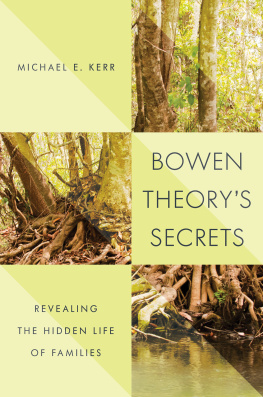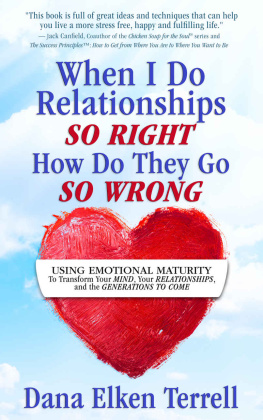Contents

BOWEN THEORYS SECRETS
BOWEN THEORYS
SECRETS
Revealing the Hidden
Life of Families
MICHAEL E. KERR

W. W. Norton & Company
Independent Publishers Since 1923
New York London
Copyright 2019 by Michael E. Kerr
All rights reserved
First Edition
For information about permission to reproduce selections from this book, write to
Permissions, W. W. Norton & Company, Inc., 500 Fifth Avenue, New York, NY 10110
For information about special discounts for bulk purchases, please contact
W. W. Norton Special Sales at specialsales@wwnorton.com or 800-233-4830
Production manager: Katelyn MacKenzie
The Library of Congress has cataloged the printed edition as follows:
Names: Kerr, Michael E., 1940 author.
Title: Bowen theorys secrets : revealing the hidden life of families / Michael E. Kerr.
Description: First Edition. | New York : W.W. Norton & Company, [2019] | A Norton
professional book. | Includes bibliographical references and index.
Identifiers: LCCN 2018028077 | ISBN 9780393708127 (hardcover)
Subjects: LCSH: Bowen, Murray, 1913-1990. | Family psychotherapyBiography.
Classification: LCC RC488.5 .K47 2019 | DDC 616.89/156dc23
LC record available at https://lccn.loc.gov/2018028077
ISBN: 978-0-39371-362-6 (ebk.)
W. W. Norton & Company, Inc., 500 Fifth Avenue, New York, N.Y. 10110
www.wwnorton.com
W. W. Norton & Company Ltd., 15 Carlisle Street, London W1D 3BS
This book is dedicated to those who have taught me much about
differentiation of self:
my mentor, Murray Bowen;
my mother, Mary Margaret Costlow Kerr;
my father, Oscar William Kerr Jr.;
my schizophrenic brother, Oscar William Kerr III;
my wife, Kathleen Bower Kerr;
and our three children, Melissa Kerr, Rachel Kerr Schmalhofer,
and Brendan Matthew Kerr.
Note to Readers: Standards of clinical practice and protocol change over time, and no technique or recommendation is guaranteed to be safe or effective in all circumstances. This volume is intended as a general information resource for professionals practicing in the field of psychotherapy and mental health; it is not a substitute for appropriate training, peer review, and/or clinical supervision. Neither the publisher nor the author can guarantee the complete accuracy, efficacy, or appropriateness of any particular recommendation in every respect.
Contents
The people that I can be quite specific about I will name individually. The first people I would like to acknowledge are the ones at W. W. Norton. My dealings thirty years ago were primarily with Susan Barrows, who encouraged me to write my first book, Family Evaluation, coauthored with Murray Bowen. Deborah Malmud, who provided extremely useful advice on my proposal for this book, and her capable assistants have been my main contacts for this time around. Norton has been a fantastic company to work with. The next group I will mention, all residents of the island of Islesboro, Maine, where I have lived full- time since June 2011, comprises Kathleen Kerr, Priscilla Fort, Charles Dupuy, and Dick De Grasse, each of whom read sections of the manuscript and made extremely useful comments. Finally, I dare not list my Bowen theory colleagues lest I forget someone. There are dozens who have been very important. I would also include many of the people I coached in my clinical practice. Watching them apply these ideas in their lives has been invaluable. Absent being able to communicate my various ideas through the years and listening to their responses, I would have been lost. The Bowen network is a collection of individuals, but it is still a team effort. Representing the ideas in Bowen theory, which still occupy the fringes of public consciousness, can be exciting and frustrating. The whole of the Bowen network is definitely greater than the sum of its parts. One other person I want to acknowledge is Ruth Riley Sagar. She was the highly capable administrative director of the Georgetown Family Center during the entire time I was involved there. I could not have accomplished what I did without her alongside, taking care of business. Murray Bowen used to refer to me as his right arm. Ruth was my right arm. She often had good ideas about how to improve whatever writing I was doing at the moment. Last but far from least are the many scientists who have interacted with members of the Bowen network for many years. They have kept our group honest, reducing the tendency of any of us to drift into the ozone layer on some of our speculations. As Murray Bowen often said, If you have questions about theory, go back to the rats. The rats dont lie. I wont try to interpret what Bowen meant by that, but it was relevant to the scientists who collect the facts about the flora and fauna, of which Homo sapiens is a cardcarrying member.
The examples presented in this volume, although derived from actual cases in my practice, are composites. They nonetheless exemplify approaches and dialogue I have found effective in my practice.
The title of this book, Bowen Theorys Secrets: Revealing the Hidden Life of Families, was strongly influenced by reading The Hidden Life of Trees by Peter Wohlleben (2015). Quoting from the book jacket: Trees are like human families: tree parents live together with their children, communicate with them, support them as they grow, share nutrients with those who are sick or struggling, and even warn each other of impending dangers. Forester Peter Wohlleben describes trees as social beings and the forest as a social network. The life of a tree is intricately connected to the lives of other trees in ways most people are unaware. The successful adaptation of a tree to lifes challenges cannot be adequately understood without examining its links to its social network, and the same holds for members of human families. How one family member is adapting to lifes challenges cannot be adequately understood separate from that individuals relationships with other family members.
Despite Bowen theory being based on research begun more than seventy years ago, the value of viewing human beings as profoundly emotionally driven creatures and human families functioning as emotional units has yet to significantly penetrate the public consciousness. Nor has the view of the forest as a social network penetrated the public consciousness. Both insights are secret, or at least largely hidden from view. This is obviously not the result of a conspiracy to suppress the information but, in the case of the family as an emotional unit, requires a radical and thus difficult shift in conceptual thinking. Most people acknowledge that the family is critically important to human health and well-being, but few are aware of the emotional forces and patterns of interaction in all families that govern whether the unit functions as a resource or stressor for its members.
I want to forewarn readers that I have packed many complex ideas into this introduction, hoping to alert at the outset those unfamiliar with Bowen theory to the breadth and depth of the ideas. Part I of the book explicates the core ideas in the theory. Part II describes the process of differentiation of self, which is the most important application of Bowen theory. People sometimes think of theories as ivory tower productions: interesting but not necessarily practical. Differentiation of self is anything but ivory tower; it has a well-tested real-world application. Part III includes four long case presentations of families in the public eye. They each illustrate how Bowen theory can help explain how familiesthree of which appear fairly normal and one of which does notunwittingly produce an offspring that chronically manifests some type of severely aberrant behavior. Part IV proposes a new concept to include in Bowen theory and discusses a concept proposed by Bowen that attracted great interest at the time but never materialized as part of the theory. The epilogue describes the application of Bowen theory to understand my family of origin and develop more ability to function as a differentiated self in it. My parents raised four sons, three of whom made reasonable life adjustments. The other son committed suicide when he was thirty-five years old. The study of my family illustrates how stressors related to changes in the family relationship system over time better predict the clinical course of schizophrenia (a diagnosis my brother received) than the conventional view of a pathology-driven process with a natural history.












